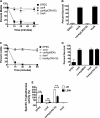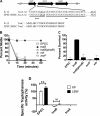CsrA and TnaB coregulate tryptophanase activity to promote exotoxin-induced killing of Caenorhabditis elegans by enteropathogenic Escherichia coli
- PMID: 21705596
- PMCID: PMC3165518
- DOI: 10.1128/JB.05197-11
CsrA and TnaB coregulate tryptophanase activity to promote exotoxin-induced killing of Caenorhabditis elegans by enteropathogenic Escherichia coli
Abstract
Enteropathogenic Escherichia coli(EPEC) requires the tnaA-encoded enzyme tryptophanase and its substrate tryptophan to synthesize diffusible exotoxins that kill the nematode Caenorhabditis elegans. Here, we demonstrate that the RNA-binding protein CsrA and the tryptophan permease TnaB coregulate tryptophanase activity, through mutually exclusive pathways, to stimulate toxin-mediated paralysis and killing of C. elegans.
Figures



Similar articles
-
Paralysis and killing of Caenorhabditis elegans by enteropathogenic Escherichia coli requires the bacterial tryptophanase gene.Mol Microbiol. 2005 Aug;57(4):988-1007. doi: 10.1111/j.1365-2958.2005.04739.x. Mol Microbiol. 2005. PMID: 16091039
-
Physiological studies of tryptophan transport and tryptophanase operon induction in Escherichia coli.J Bacteriol. 1991 Oct;173(19):6009-17. doi: 10.1128/jb.173.19.6009-6017.1991. J Bacteriol. 1991. PMID: 1917834 Free PMC article.
-
Characterization of the tryptophanase operon of Proteus vulgaris. Cloning, nucleotide sequence, amino acid homology, and in vitro synthesis of the leader peptide and regulatory analysis.J Biol Chem. 1992 Oct 5;267(28):19978-85. J Biol Chem. 1992. PMID: 1400314
-
Transcription attenuation: once viewed as a novel regulatory strategy.J Bacteriol. 2000 Jan;182(1):1-8. doi: 10.1128/JB.182.1.1-8.2000. J Bacteriol. 2000. PMID: 10613855 Free PMC article. Review. No abstract available.
-
Post-transcriptional global regulation by CsrA in bacteria.Cell Mol Life Sci. 2010 Sep;67(17):2897-908. doi: 10.1007/s00018-010-0381-z. Epub 2010 May 6. Cell Mol Life Sci. 2010. PMID: 20446015 Free PMC article. Review.
Cited by
-
Atypical Enteropathogenic Escherichia coli: from Kittens to Humans and Beyond!Infect Immun. 2021 Feb 16;89(3):e00752-20. doi: 10.1128/IAI.00752-20. Print 2021 Feb 16. Infect Immun. 2021. PMID: 33361199 Free PMC article.
-
Metabolome and transcriptome-wide effects of the carbon storage regulator A in enteropathogenic Escherichia coli.Sci Rep. 2019 Jan 15;9(1):138. doi: 10.1038/s41598-018-36932-w. Sci Rep. 2019. PMID: 30644424 Free PMC article.
-
Nutrient-responsive regulation determines biodiversity in a colicin-mediated bacterial community.BMC Biol. 2014 Aug 27;12:68. doi: 10.1186/s12915-014-0068-2. BMC Biol. 2014. PMID: 25159553 Free PMC article.
-
In vitro and in vivo model systems for studying enteropathogenic Escherichia coli infections.Cold Spring Harb Perspect Med. 2013 Mar 1;3(3):a009977. doi: 10.1101/cshperspect.a009977. Cold Spring Harb Perspect Med. 2013. PMID: 23457294 Free PMC article. Review.
-
A family of indoles regulate virulence and Shiga toxin production in pathogenic E. coli.PLoS One. 2013;8(1):e54456. doi: 10.1371/journal.pone.0054456. Epub 2013 Jan 23. PLoS One. 2013. PMID: 23372726 Free PMC article.
References
-
- Aballay A., Ausubel F. M. 2002. Caenorhabditis elegansas a host for the study of host-pathogen interactions. Curr. Opin. Microbiol. 5:97–101 - PubMed
-
- Anyanful A., et al. 2005. Paralysis and killing of Caenorhabditis elegansby enteropathogenic Escherichia colirequires the bacterial tryptophanase gene. Mol. Microbiol. 57:988–1007 - PubMed
-
- Baker C. S., Morozov I., Suzuki K., Romeo T., Babitzke P. 2002. CsrA regulates glycogen biosynthesis by preventing translation of glgCin Escherichia coli. Mol. Microbiol. 44:1599–1610 - PubMed
Publication types
MeSH terms
Substances
Grants and funding
LinkOut - more resources
Full Text Sources
Molecular Biology Databases

